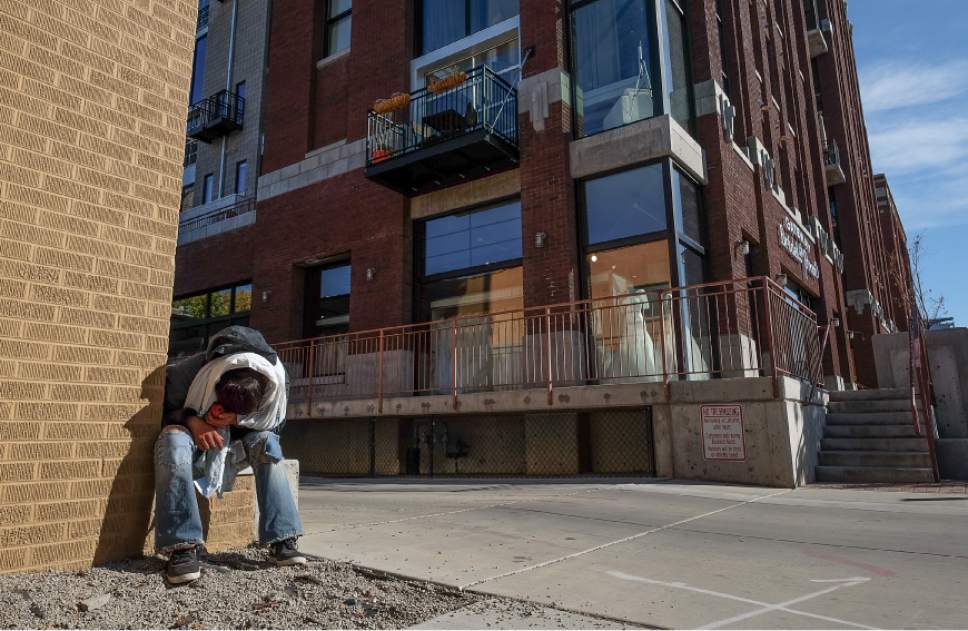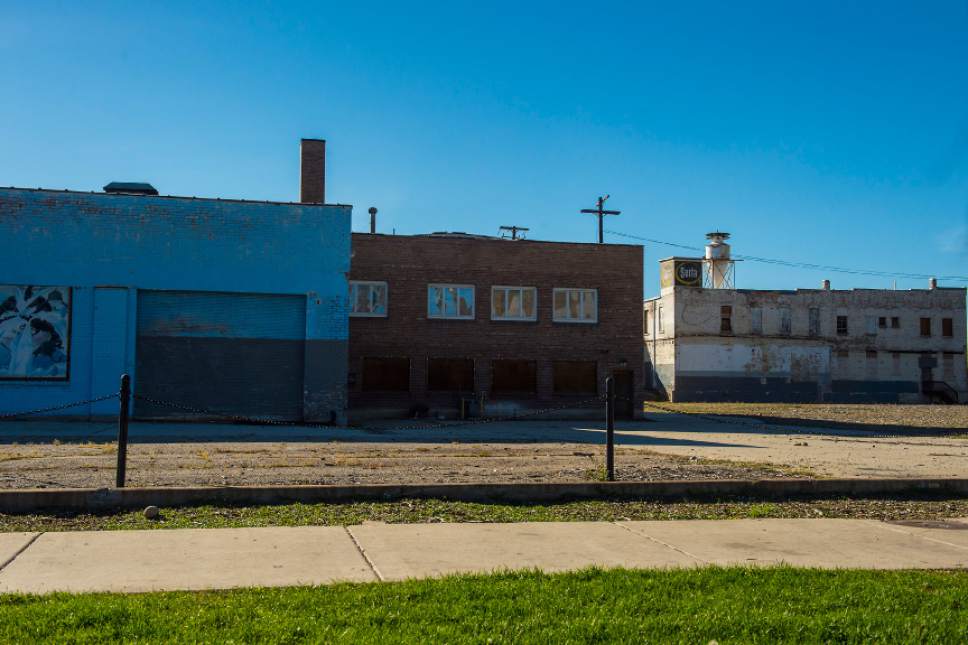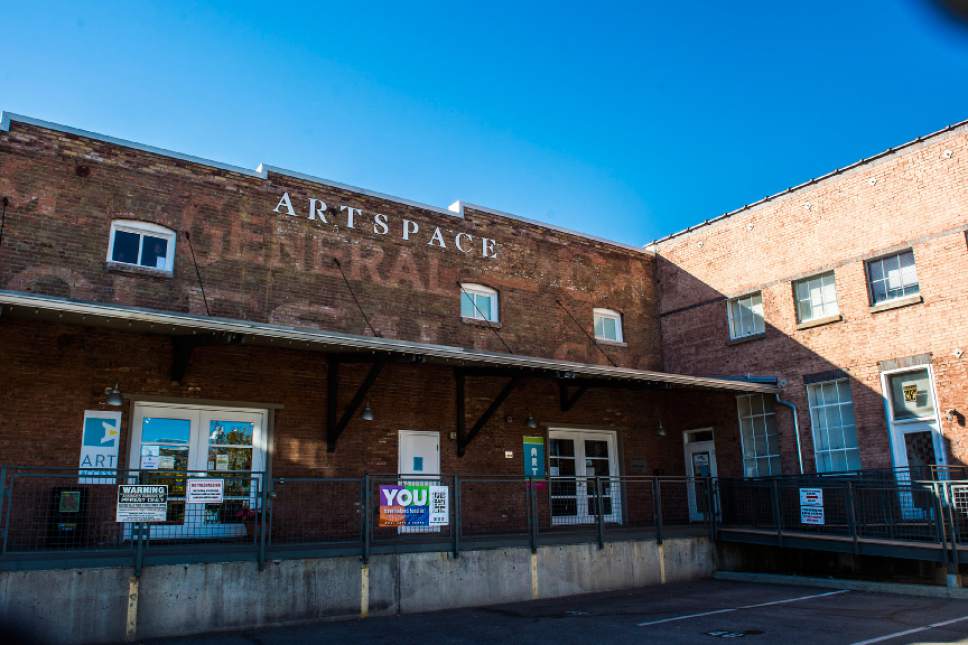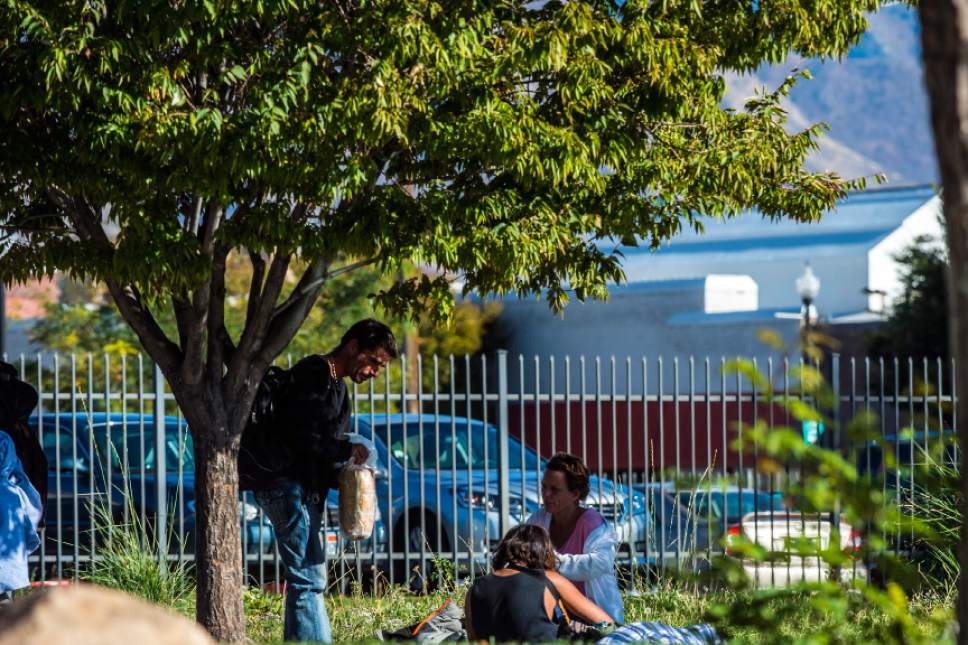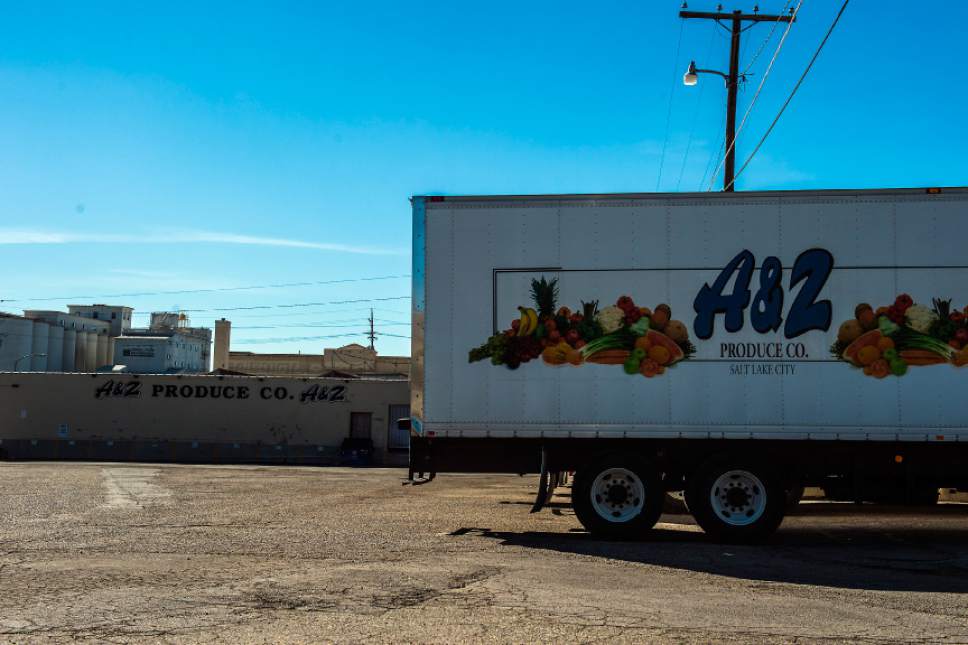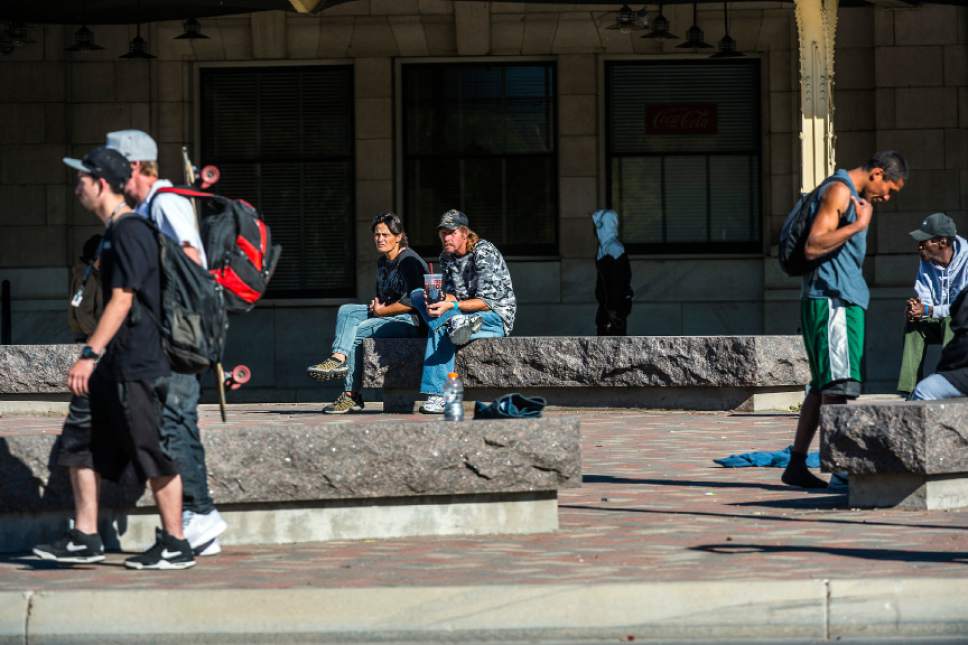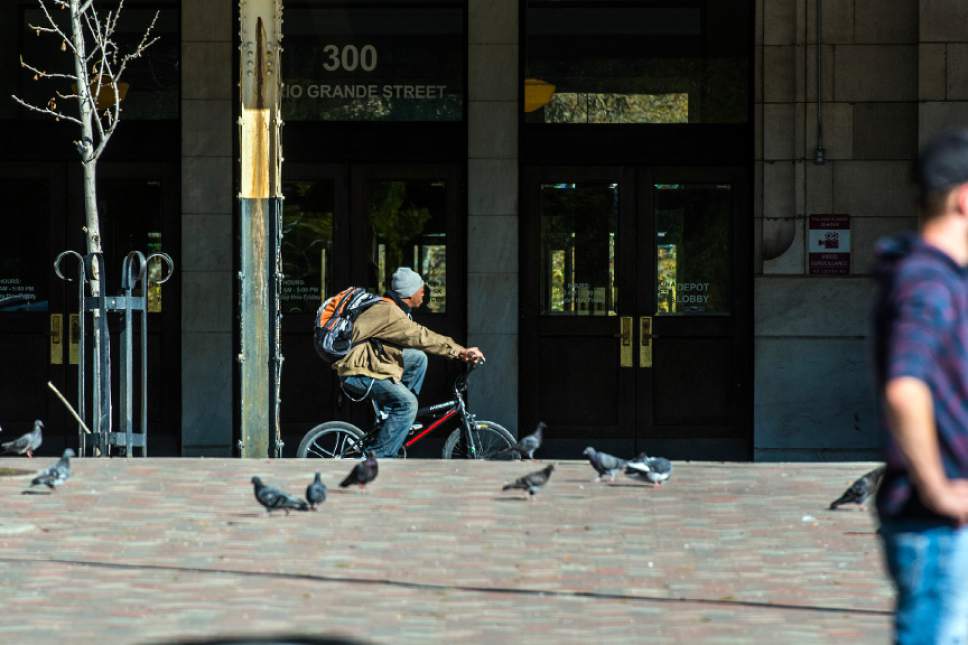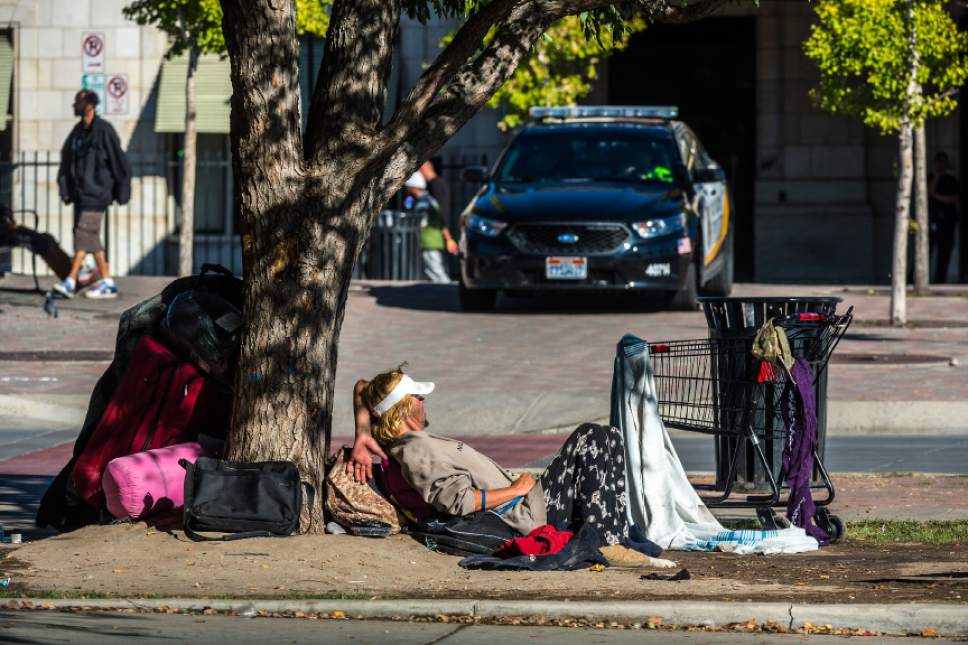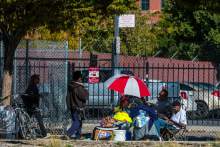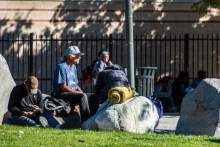This is an archived article that was published on sltrib.com in 2016, and information in the article may be outdated. It is provided only for personal research purposes and may not be reprinted.
A dead man lay 10 feet from the door to Richard Thomas' shop.
An employee of his electric motor company heard the gunshot that struck the suspected drug dealer in the neck, but Thomas didn't rush to see the crime scene. He couldn't stomach it. He continued working as police stepped around the corpse on the cold cement. And he tried to focus as they covered it in a white sheet.
With yellow tape enveloping the entrance to Thomas Electric, his family business, Thomas allowed his mind to drift over the episode.
"What's worse than a murder?" he thought.
The dead man died in a drug deal gone south, according to the police report, just a few blocks northwest of a downtown Salt Lake City homeless shelter. For years, criminals have hidden out among the homeless in the Rio Grande District along 500 West, between 200 South and 400 South.
The problem, though, is getting worse, spreading blocks away and landing, quite literally, in front of small businesses to the point that political and civic leaders call it a crisis and shop owners call it unbearable. Five stores, in fact, have left and more are threatening to bolt.
Many say customers fear coming to an area plagued by brawls, shootings, stabbings and more. Most agree the city, despite its recent initiatives, hasn't done enough to bring order to the chaos.
"I lay this whole thing on the city. It's entirely their fault," said Thomas, who is thinking of leaving. "They have not been willing to manage the problem like it needs to be managed."
Hope or hopeless?
When built in the mid-1980s, The Road Home at the heart of the Rio Grande District, was intended to house 175 people. Since then, the shelter has expanded to include room for more than 1,000.
Other people create makeshift tents out of rope, tarps and blankets. They sleep next to a concrete wall bearing a promising message: "Hope for the future gives us strength for today."
Salt Lake City Mayor Jackie Biskupski's office believes there is hope.
Crews put in new lights and portable restrooms. They removed large rocks, which were being used as weapons. And police launched "Operation Diversion" to funnel drug dealers to jail and drug users to treatment.
Still to come: four new, smaller homeless shelters.
"We're trying to do all that we can do, big and small, to really try and make that area safer," said Matthew Rojas, the mayor's spokesman. "This is a problem that has existed for years and years and businesses have been dealing with it for years and years."
But store owners yearn for something more dramatic: Many want the homeless services, including The Road Home, relocated.
That isn't on the table, leaving businesses that fear they are on the slow march to bankruptcy or foreclosure with a decision: stay or go.
'Line of fire'
Nicole Thomas hurriedly boxed up bundles of tulle gowns and lace veils. She had to get out while she could.
In five days, Thomas, who is not related to Richard Thomas, packed up her wedding dress shop, Gateway Bridal & Prom, across from the shelter, and reopened about two blocks north on Broadway, where she felt "immediately safer."
"It's a substantial difference not walking out into the war zone and that line of fire," she said from her new office, where a small bonsai tree and the latest wedding catalogs adorn a light brown desk. Her window looks out on a brick wall and driveway. It's hardly picturesque, she concedes, but it sure beats her previous view.
At her former shop, used syringes filled the cracks in the sidewalks of what she dubbed "the McDonald's of drug trafficking."
"We were having issues with people shooting up heroin in our bathrooms, people defecating on the perimeter of our building," she said. "A man ... urinated on the window while I was working."
At one point, a female employee saw a drug deal, Thomas said. A man came up behind her and snapped, "You didn't see nothing, b——. Keep walking."
It all got to be too much. Each day Thomas came into the shop, her thoughts alternated between "I can't wait until I get out of here" and "I hope nothing too traumatic happens."
Though she didn't move far — Thomas loves the Rio Grande District too much to leave entirely — she said the city's short-term remedies are not moving fast enough. Operation Diversion, she said, is a "step in the right direction" but is no cure-all.
Sirens sounded as she spoke, passing loudly by her shop and not completely fading out as an ambulance pulled over a few blocks away at the shelter. It reminded Thomas of her shop's previous digs at ground zero.
"It wears on your psyche day in and day out," she said. "There's kind of an oppression in the air. It felt like you were in 'The Walking Dead.' "
Thomas saw other stores flee before she did and worries that, without more collective action from the city and Salt Lake County, the entire area will be abandoned. The Pioneer Park Coalition, an advocacy group for developers, shop owners and residents in the district, is working to avoid that kind of domino defection.
"Every time a business leaves that's another dark window," said the coalition's executive director, Jonathan Harman. "We're scared that's going to make everybody leave. Everybody's threatening that right now."
The Rio Grande District has about 100 shops, Harman said. He keeps a list of the places that have folded up (Iggy's Sports Grill, Cafe Trang, Ernst & Young, Gateway Bridal and Spy Hop) and the ones in limbo (a much longer tally that includes A&Z Produce, Thomas Electric, Romney Group, even the venerable Rio Grande Cafe).
Businesses that don't leave sometimes make adjustments: Clark Planetarium renovated its entrance after homeless people kept coursing through the open foyer to use the public facility's restrooms. The front doors now channel visitors past a county sheriff's deputy station, which may cut down on the number of unwanted guests sharing the same space as school kids on field trips.
Fed up
As Pete Henderson's staffers bustle around serving their signature enchiladas and tamales, restless groups of homeless men and women linger outside.
They return each day, snaking through the cars in the parking lot and panhandling to patrons on the patio of Henderson's Rio Grande Cafe.
The owner keeps the blinds closed but he knows they are out there. He's constantly reminded when someone leaves behind a check with a note saying, "I'm sorry. I love the place, but I can't come here anymore."
In the past five years, Henderson said, he's lost half his customers, plunging from 12,000 diners a month to about 6,000.
"People don't even make it to our front door oftentimes," he said. "We see them do U-turns."
Henderson had to lay off about 10 employees — some of whom had worked with him for 25 years. But even his scaled-back staff of 35 seems like too many at times.
He opened the Mexican restaurant in 1981 in the historic Rio Grande Depot. Now, with the homeless hordes, he's weighing whether to close. If Henderson goes, he'll be gone for good.
"I'm 66 years old — I can't start over," he said, "nor would the Rio Grande Cafe be the same restaurant in a different location."
Henderson has met with local leaders but said they don't address his concerns. Homeless shelters, he argues, are "incompatible with commerce" and shouldn't share the same space. He wants The Road Home to leave the neighborhood, though the shelter's director, Matt Minkevitch, lobbies for it to stay.
Creating the four new shelters wouldn't eliminate the need for The Road Home to provide emergency housing, Minkevitch said, but "[it] would be very helpful for many who are in serious need of help."
"A growing number of people are turning to the downtown shelter, and the demand is challenging our agency's capacity," he said. "The impact on the neighborhood is significant; additional shelters would help to provide people a way out of the 500 West and Rio Grande corridor."
But Henderson warned the "game of chicken" businesses are playing when they threaten to leave is about over. Store owners no longer want to stay and defend their space.
Richard Thomas, of Thomas Electric, has asked Biskupski's administration to move the shelter near Salt Lake City International Airport next to the planned prison. Each time he's gotten a resounding "no."
If conditions don't improve, after 86 years operating in the Rio Grande area, his shop might become another dark window.
Weathering the storm
It's 7 a.m. on a Sunday and Michael Zimmerman is leading a meditation at his studio. His clients are calm, quiet, mindful.
Outside a shirtless man in gray sweatpants slides in between police vehicles, and a baby cries after a metal can gets tossed onto the sidewalk.
Though the two scenes seem to clash, Zimmerman, a former Utah Supreme Court justice who's now a Zen teacher, believes they're not so different.
"One of the things we emphasize is learning to generate a sense of compassion toward yourself and others," said the owner of Two Arrows Zen. "You walk outside and you see how hard it is."
Located in the Artspace complex, Zimmerman's studio is across the street from the shelter. After renovating his shop over the past five years, he plans to stay.
His decision doesn't mean there are no issues — the parking lot to his business gets filled with drug dealers and garbage. He spends about $50 a week for someone to clean it and "make it look not lived in" before his clients arrive.
Zimmerman's solution mirrors the city-county plan: "Disperse" the homeless instead of crowding them into one shelter.
A board member of the Fourth Street Clinic, which provides health care to the homeless, he believes spreading the group to several locales may complicate providing services, but it will "dilute" the drug trade and make the Rio Grande District safer.
Change on the horizon
Justin Belliveau, chief administrative officer with Salt Lake City's Redevelopment Agency, applauds the shops that have the "courage" to stay despite the circumstances. And he vows that new developments will help in the long run: "In three or five years there will be a major transition."
The city, which owns nine acres along 300 South between 500 West and 600 West, has unveiled plans for hundreds of new apartments, shops, offices and a year-round public market. The two-block overhaul, known as Station Center, is intended to revitalize the nearby Depot District.
When the project details were released, one partner said the close proximity to the shelter "remains an issue" but wasn't a deal breaker. While it hasn't delayed the timeline for the renovations — set to be completed by 2020 or 2021 — Belliveau acknowledged some developers are cautious.
Until the new developments and additional shelters are in place, though, Zimmerman insists the best way forward is to weather the storm and sympathize with those facing hard times.
As he talks, his dog, Bear, an Australian shepherd blue heeler, wanders around the room and barks when someone walks past the translucent door.
"Someone in the Bible — was it Jesus? — said the poor will always be around us," Zimmerman said, adjusting his brown circular frames with one hand and playing with a leash in the other. "But we just don't have to have them all in the same place."
ctanner@sltrib.com Twitter: @CourtneyLTanner



